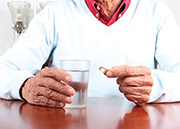| |
| |
| |
 |
|
@{mv_date_MMM d, yyyy}@ |
|
| |
The pandemic has created a cyclical public health problem by harming mental health while also making it more difficult for people to maintain physical activity, report researchers.
» Read more...
Study finds diet may contribute to cognitive resilience in the elderly.
» Read more...
It’s basic exercise knowledge that to gain muscles, you strength train, and to lose fat, you do cardio — right? Not necessarily, a new UNSW study published this week in Sports Medicine suggests.
» Read more...
|
| |
|
| |

This book embraces the philosophy of “active” conservative care and encourages a multidisciplinary team approach to the treatment and rehabilitation of athletic injuries. In addition to site specific sports injuries, including ankle, spine, knee, and shoulder injuries, chapters address the sports medicine aspects of medicolegal issues, diagnostic imaging, strength and conditioning, nutrition, and anabolic steroid use in sports. Includes specific recommendations for women, young athletes, and seniors.
» Shop now |
| |
|
| |
 The hallmark of the pathology of Alzheimer’s dementia is the accumulation of beta-amyloid protein fragments that have aggregated outside neurons in the brain. Also of importance are tau tangles that are twisted in neurons and eventually lead to the death of neurons thereby affecting brain tissue. This pathological development occurs progressively over many years before symptoms emerge. One of the concerns regarding the development of dementia is the ability to create new neural connections. Synaptogenesis is the creation of new synapses resulting in new connections between pre-existing brain neurons. Brain neurons form synapses throughout the life span. This process is initiated by neuronal depolarization, however the numbers of synapses formed is dependent on the level of three key nutrients—uridine, the omega-3 fatty acid DHA, and choline.
» Read more...
The hallmark of the pathology of Alzheimer’s dementia is the accumulation of beta-amyloid protein fragments that have aggregated outside neurons in the brain. Also of importance are tau tangles that are twisted in neurons and eventually lead to the death of neurons thereby affecting brain tissue. This pathological development occurs progressively over many years before symptoms emerge. One of the concerns regarding the development of dementia is the ability to create new neural connections. Synaptogenesis is the creation of new synapses resulting in new connections between pre-existing brain neurons. Brain neurons form synapses throughout the life span. This process is initiated by neuronal depolarization, however the numbers of synapses formed is dependent on the level of three key nutrients—uridine, the omega-3 fatty acid DHA, and choline.
» Read more... |
| |
|
| |
|
|
| |
| |


